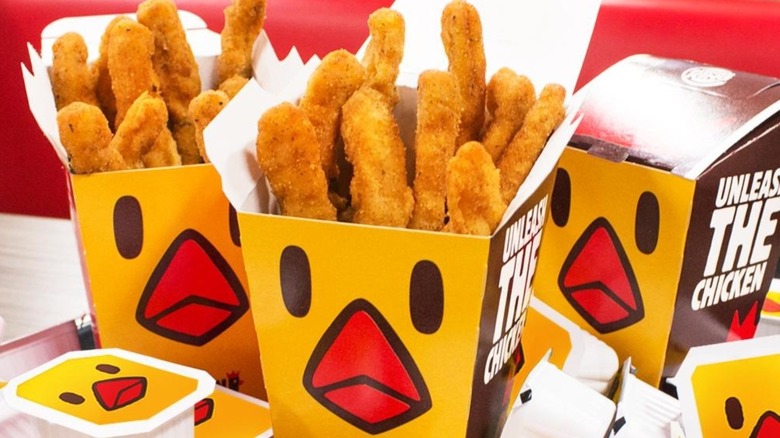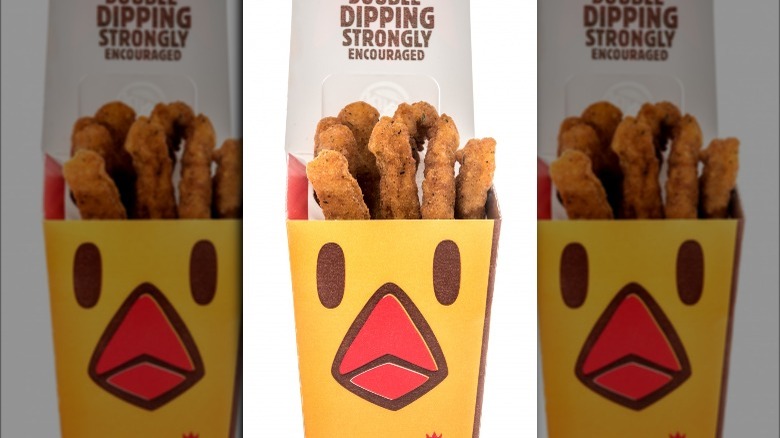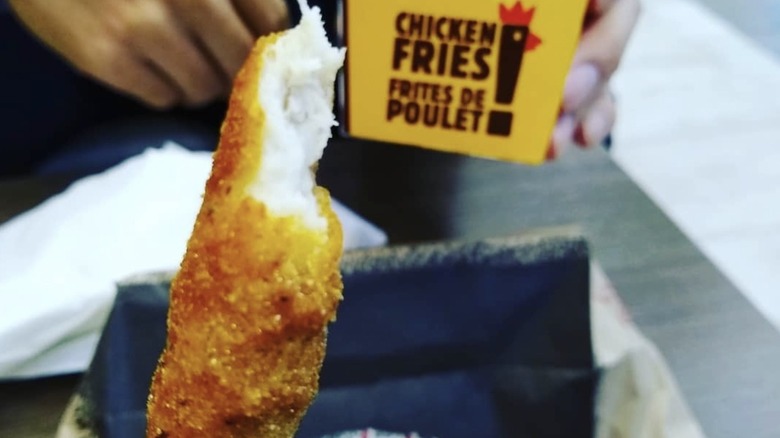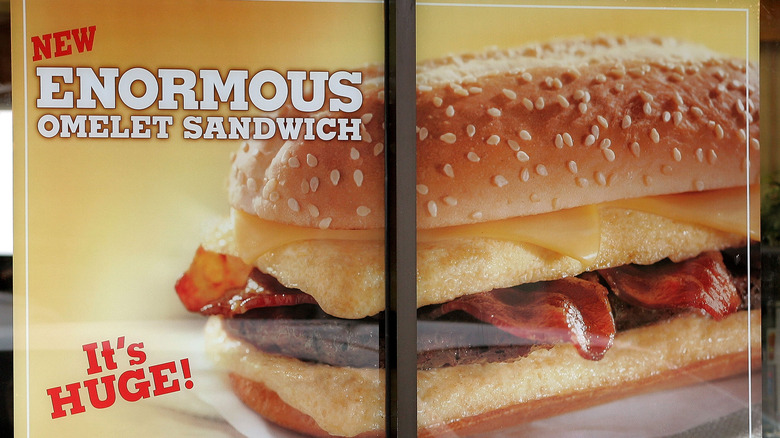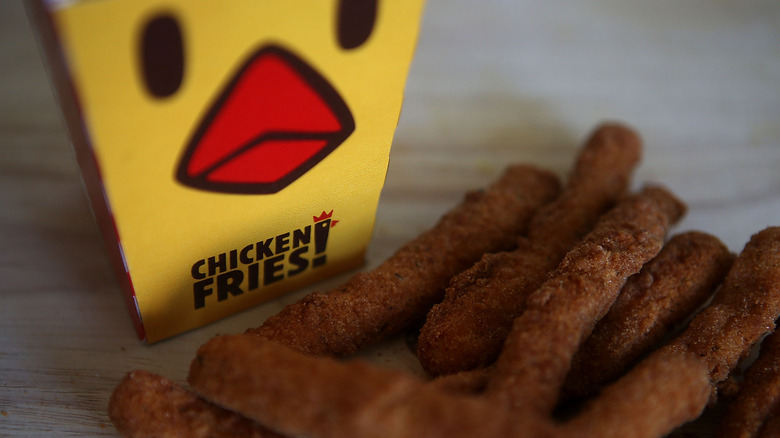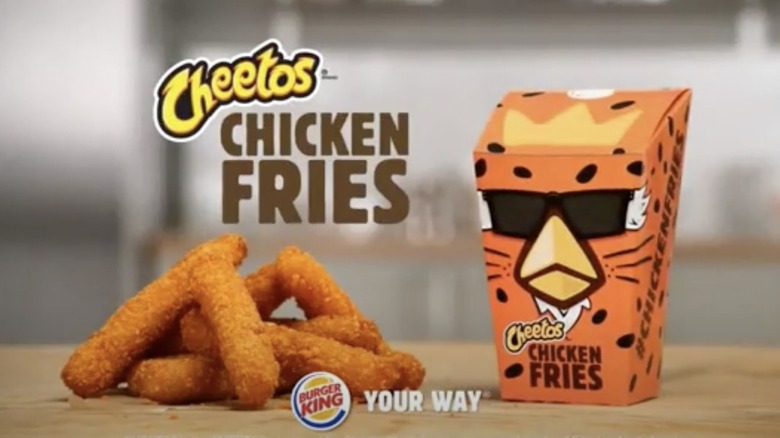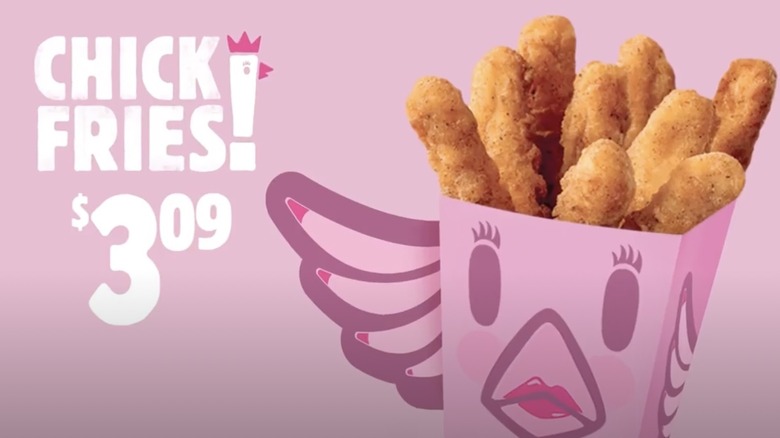The Untold Truth Of Burger King's Chicken Fries
Plenty of fast food items have inspired a loyal devoted cult audience, but no product category unleashes quick-serve fervor like different chains' signature chicken items. Wendy's Spicy Chicken Nuggets have a massive following, as does the Popeye's Chicken Sandwich, and pretty much the whole menu of Chick-fil-A. But the one salty, savory, breaded and fried fowl product to rule them all just might be Burger King's long, narrow, meaty, and peppery take on (and competitor to) the Chicken McNugget: the BK Chicken Fries.
Since its introduction in 2005, BK Chicken Fries have appeared temporarily and sporadically on the Burger King menu, both arriving and leaving with much fanfare and promotion. Burger King die-hards rank the unique chicken product — resembling French fries, but assembled out of ground up and spiced chicken — as one of the venerable chain's most tasty and innovative items. Customers were rewarded for their loyalty when BK Chicken Fries were permanently added to the Burger King big menu board in 2015, according to USA Today.
Here's everything there is to know — really, the whole clucking story — about those irresistible and almost inexplicably highly regarded menu items known as the BK Chicken Fries.
BK Chicken Fries are carefully crafted, and so is the box
The terms "chicken tender," "chicken nugget," and "chicken finger" are not necessarily interchangeable. Per Mic, chicken tenders are from a specific part of the chicken known as an inner filet, while nuggets are made up of various edible chicken parts (both white and dark meat) that are chopped and formed. Meanwhile, chicken "fingers" are made up of strips of whole muscle from the same individual animal. According to QSR, BK Chicken Fries are technically chicken fingers, because they're made from strips of whole muscle, white meat-only chicken breast.
The one thing all these different styles of fast-food boneless chicken have in common is that chains really push the dipping sauces regardless. Upon the initial product launch in 2005, Burger King offered a selection of dipping sauces for the BK Chicken Fries, including barbecue, honey mustard, ranch, sweet and sour, and creamy buffalo. Proper placement and easy use of that dip factored into the BK Chicken Fries box."We spent a tremendous amount of time and resources testing this new menu offering, along with its packaging," Russ Klein, chief global marketing officer for Burger King, told QSR.
Then and today, a standard-size order of BK Chicken Fries typically arrives in a tall, narrow box, meant to resemble a French fry container, though more rectangular and closed at the top. It was carefully designed to fit into a car's cup holder, making for an easy, portable, and drive-through-friendly menu item.
The people asked for BK Chicken Fries
In 2010, Burger King was acquired by an investment firm, which put the fast food chain into an umbrella corporation of restaurants and then set out to restructure the business top to bottom (via Business Insider). The menu was cut by 2014, but then the company actually wound up adding an item to its supposedly pared-down menu.
"One of probably the biggest moments in the business from a shift-in-mindset standpoint was when we re-launched the Chicken Fries," CEO of Restaurant Brands International José Cil told Business Insider. "It was a great example of our team mining social media and connecting with our younger guests." A college student enrolled in the company's Leadership Development Program noticed that Burger King's social media data was predominantly filled with discussion of a Chicken Fries comeback. There was even a Change.org petition going, underlying the intense desire for a return of the Chicken Fries to the BK menu.
Acting on the hunch that this is what the public (or at least the chain's most loyal customers) wanted, Cil said that Burger King went on a fact-finding mission. This effort included focus group testing, as well as a redevelopment of the Chicken Fries. All that effort and research ultimately paid off. The new Chicken Fries sold fantastically well upon the menu item's 2014 relaunch, to the point where Burger King added them to the forever menu in 2015.
BK Chicken Fries are the last survivor of a Burger King experiment
In 2003, according to Newsweek, Burger King stumbled pretty darn hard with a line of three low-fat sandwiches that were announced after a "healthy" Happy Meal hit the McDonald's menu (via Orlando Sentinel). The experiment, which included a garden salad and bottled water in place of fries and a soda, flopped. Some postmortem market research revealed that frequent fast food eaters made up 18 percent of Americans but were responsible for nearly half of quick-serve business. Under the guidance of then-CEO Greg Brenneman, Burger King eschewed the healthy stuff and went all-in on the biggest, greasiest, meatiest, food possible. And it was all because the customers who wanted that stuff were those who, in Brenneman's words, "will drive business."
Over the next couple of years, Burger King tried out a number of not-so-health-conscious menu items, such as a big chicken sandwich topped with pepper jack cheese, massive Angus Steak Burgers, the Enormous Omelet Sandwich, the TenderCrisp Chicken Sandwich, BK Stackers (made up of meat patties, cheese, and bacon, available in servings of one to four per sandwich), and BK Chicken Fries. The Chicken Fries in particular were touted as much meatier and more substantial than Burger King's chicken nuggets.
But BK's foray into fast food bacchanalia wasn't a resounding success, either. Over time, all of those new items were discontinued, including BK Chicken Fries. But only those sticks of fried fowl returned to the menu permanently in 2015.
BK Chicken Fries reinvigorated Burger King
That innovative success of BK Chicken Fries, thanks to a proverbial ear-to-the-ground strategy and a willingness to try some rather daring new things, led to big business for Burger King in the 2010s. Without BK Chicken Fries leading the way, and the company actively listening to "what the guest wants," this would have been potentially dire, as Burger King parent corporation José Cil told Business Insider. Without that game plan, there wouldn't have been promotions like Mac n' Cheetos, a $5-a-month, all-you-can-drink coffee deal, or the Extra Long Pulled Pork Sandwich.
According to CNN Business, the popularity of BK Chicken Fries — and its experimental, only-available-for-a-limited-time spiritual descendants — directly boosted the restaurant's business both quickly and significantly. In the second quarter of 2015, in the months just after the permanent re-addition of BK Chicken Fries to the menu, same-store sales jumped by about 7 percent. Meanwhile, sales at BK's fast food arch-rival, McDonald's, fell by 2 percent in the United States market and 0.7 percent worldwide.
Burger King experimented with wilder varieties
In the wake of audience outreach resulting in the return of BK Chicken Fries, Burger King tried to determine what its customers wanted. This certainly came up when the chain decided to expand its line of chicken nuggets. According to BusinessWire, 50 percent of people in a survey claimed to prefer spicy things, so in August 2015, BK introduced its Fiery Chicken Fries. These fries turned up the heat with a marinade made up of spices including black pepper and cayenne. Unlike the original recipe BK Chicken Fries, Fiery Chicken Fries were a limited-time-only product that stayed that way, disappearing from Burger King months after introduction. They were then replaced by the fleetingly available Buffalo Chicken Fries.
In 2016, the chain went a bit wilder yet with the debut of Cheetos Chicken Fries, per Business Insider. Served in an orange box featuring a sunglasses-clad chicken with whiskers (meant to resemble the famed Cheetos mascot Chester Cheetah), the product consisted of white meat chicken rolled in a coating made up primarily of powdered, cheesy Cheetos. Again, these were temporary menu items that soon disappeared from Burger King locations everywhere.
BK Chicken Fries got Burger King sued by a popular metal band
In a promotion for its TenderCrisp Chicken Sandwich in 2004, per AdWeek, Burger King customers could go to an interactive website and tell a person in a chicken costume how to behave. Burger King liked the results of that campaign, and so it rehired advertising company Crispin Porter & Bogusky to market BK Chicken Fries in 2005.
According to Crispin Porter & Bogusky's Tom Zukoski, the agency devised a fake punk-metal band called Coq Roq. Marketing materials explained that the band had signed with Burger King rather than a record label. Hired musicians in monstrous masks with names like "Fowl Mouth" and "Free Range" (via New York Times) recorded an EP and made two music videos. However, a planned concert tour was canceled because the Canadian lead singer couldn't get clearance to enter the United States.
Coq Roq looked and acted a lot like the masked band Slipknot — according to Slipknot. Per The Smoking Gun, the group alleged that after they turned down an offer to appear in a Burger King commercial, the chain's advertising agency made TV spots that ripped off the band's aesthetic. When Burger King and Crispin Porter & Bogusky failed to honor a cease-and-desist letter from Slipknot, the band sued. Burger King then countersued, arguing that Coq Roq was a style parody of multiple masked-and-costumed metal bands, such as Kiss or GWAR. According to Vice, the suits were eventually dropped.
Burger King used BK Fries to draw attention to the pink tax
According to Healthline, manufacturers and marketers doing business in the United States often engage in a business practice identified as gender-based pricing. Also known as the "pink tax," products specifically marketed to women are made to cost more than nearly identical products traditionally geared toward men — even though's there is no difference between the items other than cosmetic details, like a product's color.
Burger King thought this was insidious. At least, it wanted to call attention to the absurdity of the practice for its own economic gain, and so staged a social experiment in 2018. According to BusinessWire, a Burger King location outfitted with cameras (to record the event for posterity and YouTube) and special boxes charged men and women who ordered BK Chicken Fries different prices. The regular, non-gendered box of chicken sold for $1.69, while the same food in a pink box cost considerably more. The company provocatively and wryly called it a "chick tax" on "chick fries."
After releasing footage of the stunt on YouTube, Burger King's North America president Christopher Finazzo explained. "Burger King restaurants welcome everyone, and we see Pink Tax as extremely unfair," he said. "Everyone should pay the same for the same products." And that was how Burger King elaborately announced a temporary price reduction for BK Chicken Fries to $1.69 "for everyone."
